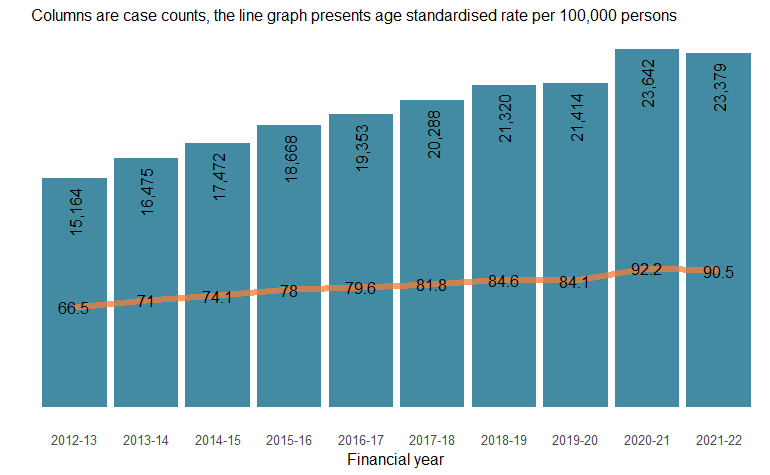Hospitalisations
In 2021-22, a total of 23,379 hospitalised cases had a primary diagnosis of an injury recorded alongside an external cause indicating contact with an animal. Contact with animals therefore represented approximately 8 out of 10 hospitalised injuries due to contact with living things, making it the 7th most frequent cause of injury hospitalisations in 2021-22.
3,226 cases were identified where the external cause of injury was a transport accident involving the rider or occupant of an animal drawn vehicle: these represent about 14% of total animal-related injury hospitalisations.
Figure 2 Comparing injury hospitalisations due to contact with animals versus those due to contact with living things, 2021-22
Notes: Contact with animals is a subset of Contact with living things, which includes animals, people and plants as external causes of injury. See technical notes and Injury in Australia for ICD10-AM codes included in both categories.
A further 73 hospitalised cases of injury were identified in 2021-22 where contact with animals was an external cause recorded alongside an additional diagnosis (not a principal diagnosis) of injury. 61 of these cases had a principal diagnosis of unspecified anaphylaxis or anaphylactic shock (T78.2), with 25 of these cases being due to bee allergies (Y37.61). These 73 cases where injury was an additional diagnosis have been excluded from the rest of this report.
1,019 injury hospitalisation cases were excluded from this report because the external cause of injury may have included people or plants.
In 448 (44%) of these excluded cases the external cause of injury was contact with living things;
- 238 cases of Exposure to other and unspecified animate mechanical forces (W64)
- 170 cases of Contact with other specified venomous marine animals and plants (X26.8).
In 571 (56%) of these excluded cases the external cause of injury was a transport accident that may have involved an animal or pedestrian;
- 282 cases of Motorcycle rider injured in collision with pedestrian or animal (V20)
- 142 cases of Pedal cyclist injured in collision with pedestrian or animal (V10)
- 136 cases of Car occupant injured in collision with pedestrian or animal (V40).
Trends
Between July 2012 and June 2022, the number, proportion and age standardised rate of hospitalised injuries due to contact with animals all gradually increased (Figure 3).
Figure 3: Trends in hospitalised injury by financial year, 2012-22

Source: National Hospital Morbidity Database
For more information please refer to supplementary data table 1.
Hospitalisations increased notably in 2020-21 with 2,228, or 10%,more hospitalisations than 2019-20. This may be attributable to increased exposure to animals secondary to increases in pet ownership during COVID-19 (Animal Medicines Australia and Newgate Research 2021).
The age standardised rate (ASR) accounts for population increases and different age distributions over the decade. The age standardised rate of hospitalisation for these injuries (per 100,000 people) gradually increased from about 66 in 2012-13 to 90 in 2021-22, peaking at about 92 in 2020-21.
AIHW (2023). Injury in Australia. Canberra, Australian Institute of Health and Welfare
Animal Medicines Australia and Newgate Research (2021). Pets and the Pandemic: A social research snapshot of pets and people in the COVID-19 era: 1-35.


